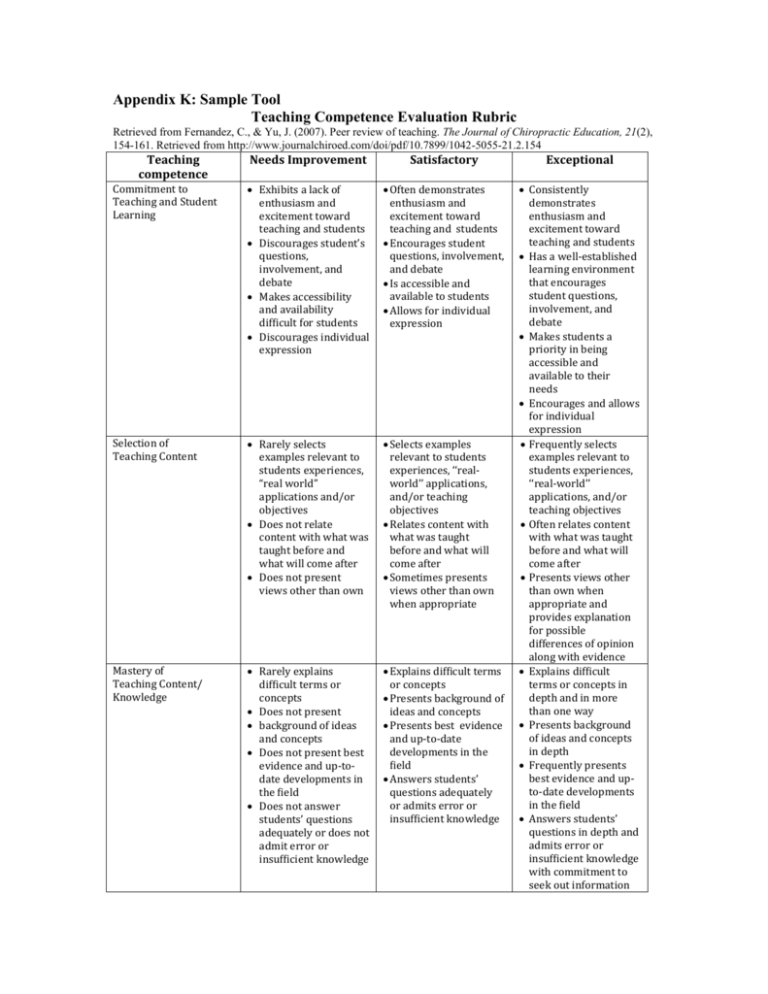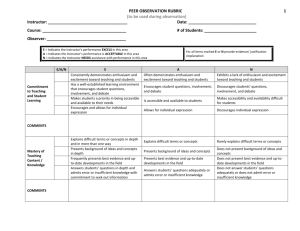Teaching Competence Evaluation Rubric
advertisement

Appendix K: Sample Tool Teaching Competence Evaluation Rubric Retrieved from Fernandez, C., & Yu, J. (2007). Peer review of teaching. The Journal of Chiropractic Education, 21(2), 154-161. Retrieved from http://www.journalchiroed.com/doi/pdf/10.7899/1042-5055-21.2.154 Teaching competence Needs Improvement Satisfactory Exceptional Commitment to Teaching and Student Learning Exhibits a lack of enthusiasm and excitement toward teaching and students Discourages student’s questions, involvement, and debate Makes accessibility and availability difficult for students Discourages individual expression Often demonstrates enthusiasm and excitement toward teaching and students Encourages student questions, involvement, and debate Is accessible and available to students Allows for individual expression Selection of Teaching Content Rarely selects examples relevant to students experiences, “real world” applications and/or objectives Does not relate content with what was taught before and what will come after Does not present views other than own Selects examples relevant to students experiences, ‘‘realworld’’ applications, and/or teaching objectives Relates content with what was taught before and what will come after Sometimes presents views other than own when appropriate Mastery of Teaching Content/ Knowledge Rarely explains difficult terms or concepts Does not present background of ideas and concepts Does not present best evidence and up-todate developments in the field Does not answer students’ questions adequately or does not admit error or insufficient knowledge Explains difficult terms or concepts Presents background of ideas and concepts Presents best evidence and up-to-date developments in the field Answers students’ questions adequately or admits error or insufficient knowledge Consistently demonstrates enthusiasm and excitement toward teaching and students Has a well-established learning environment that encourages student questions, involvement, and debate Makes students a priority in being accessible and available to their needs Encourages and allows for individual expression Frequently selects examples relevant to students experiences, ‘‘real-world’’ applications, and/or teaching objectives Often relates content with what was taught before and what will come after Presents views other than own when appropriate and provides explanation for possible differences of opinion along with evidence Explains difficult terms or concepts in depth and in more than one way Presents background of ideas and concepts in depth Frequently presents best evidence and upto-date developments in the field Answers students’ questions in depth and admits error or insufficient knowledge with commitment to seek out information Organization Meeting Teaching Objectives Instructional Materials (Readings, Media, Visual Aids) Didactic Intern Evaluation and Achievement (Methods and Tools) Does not begin on time and is disorganized Fails to preview material to prepare students for the content to be covered in patient encounter or workshop Fails to summarize main points at the end of session Does not provide clear directions and procedures Does not plan on a daily or weekly basis Teaching content and methods do not meet stated objectives of syllabus or as stated by teacher Fails to provide students with instructional materials Begins on time Previews patient cases or session content Summarizes main points at the end of session Explains directions and procedures Plans for daily and weekly activities Begins on time in an orderly, organized fashion Consistently previews patient cases or session content Summarizes and distills main points at the end of session Consistently explains directions and procedures Plans daily and weekly activities and followsup on plans that was not able to complete Teaching content and methods are geared to stated objectives of syllabus and as stated by teacher Incorporates various instructional supports such as slides, visual aids, handouts, etc. Fails to provide students with assessment criteria and instructions Does not perform minimum number of assessments required Assessments are of poor quality, have minimal information, and do not lend themselves to meaningful student feedback Feedback is not provided or is minimal Provides to students assessment criteria, instructions, and expectations Provides satisfactory number of assessments required by department Assessments are of satisfactory quality, have adequate information, and lend themselves to meaningful student feedback Feedback to students is adequate Teaching content and methods clearly meet stated objectives of syllabus and as stated by teacher Incorporates various instructional supports such as slides, visual aids, handouts, etc; Also provides references for materials presented when appropriate Provides to students the goals of assessment, along with criteria, instructions, and expectations. Also provides examples of expectations and type of feedback given Provides beyond satisfactory number of assessments required by department Assessments are of exceptional quality, have in-depth information including comments, and lend themselves to meaningful student feedback Feedback to students is exceptional and allows for student’s self-evaluation and reflection with steps for improvement Teaching Methodology and Presentation Fails to use a variety of clinical teaching strategies to address diverse learning styles and opportunities Fails to respond to changes in student attentiveness Speech is inaudible and unclear Is unprofessional and use of humor is negative and inappropriate Fails to establish and maintain eye contact with students Does not provide demonstrations when needed Does not promote life-long learning Does not promote students to be independent learners Uses a variety of teaching strategies to address diverse earning styles and opportunities Responds to changes in student attentiveness Speaks audibly and clearly Models professionalism Establishes and maintains eye contact with students Provides demonstrations as appropriate Mentors students in life-long learning skills Allows students to be independent learners Uses a large variety of teaching strategies to address diverse learning styles and opportunities Responds to changes in student attentiveness with comfortable transition of teaching strategies Consistently speaks audibly and clearly Models professionalism and use of humor is positive and appropriate Establishes and maintains eye contact with students while communicating a sense of enthusiasm toward the content Provides demonstrations as appropriate and has students demonstrate their understanding Routinely mentors students in life-long learning skills Guides students to be independent learners Support of Department Is unaware of Is aware of Has a comprehensive Instructional Efforts department’s Department’s understanding of instructional efforts instructional efforts department’s instructional efforts Does not demonstrate Demonstrates support support of department of department Demonstrates support instructional efforts instructional efforts of department instructional efforts and demonstrates leadership in progressing instructional programs Note: This appendix is based on ideas in references 12 and 15 and the author’s experience








